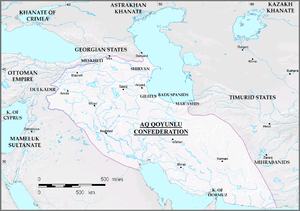Turkmen Armenia
| Turkmen Armenia | |||||
| |||||
 Ak Koyunlu tribal confederation at its greatest extent. | |||||
| Capital | Ani | ||||
| Languages | Armenian (native language) Oghuz Turkic | ||||
| Religion | Armenian Apostolic Sunni Islam | ||||
| Government | Monarchy | ||||
| Historical era | Middle Ages | ||||
| - | Established | 1335 | |||
| - | Disestablished | 1508 | |||
Turkmen Armenia or Turcoman Armenia refers to the history of medieval Armenia under the two consecutive rules of two Turkmen tribal federations known as Kara Koyunlu and then Ak Koyunlu, and the brief occupation by the Timurid Empire, until the Armenian Highlands were reincorporated into the Persianate. Due to the fact that these tribal confederations were often centered in the Armenian Highlands, contemporary sources sometimes referred to the region as "Armenia or Turcomania."

Background
Turkic tribes entered the neighbouring regions of the Armenian Highlands as early as the 6th century AD, from the brief conquest of the Caucasus by the Khazar Empire. However, they were Oghur Turks who did not leave a lasting impression on demographics of the territory. The Oghuz Turks, who paved the way for modern Turkey, Azerbaijan and Turkmenistan, entered the lands several centuries later with the conquest of the Armenian Highlands and Anatolia by the Seljuq Turks. Following the period after the collapse of the Mongol Empire and its successor in the Middle East, the Ilkhanate, various Turkic tribes rose to power in the 14th century, during which the region was often interchangeably named "Armenia or Turcomania." One of these tribes formed a tribal confederations known as the Kara Koyunlu, meaning of the Black Sheep in Oghuz Turkic.
Kara Koyunlu & Timurid Empire
Following the succession of rule by various Mongol, Turkic and Kurdish tribes since the 1335, Armenia fell under the control of the Kara Koyunlu in 1410. The principal Armenian sources available in this period come from the historian Tovma Metsopetsi and several other contemporary colophons.[1] According to Tovma, although the Kara Koyunlu levied heavy taxes against the Armenians, the early years of their rule were relatively peaceful and some reconstruction of towns took place. This peaceful period was, however, shattered with the rise of Qara Iskander, who reportedly made Armenia a "desert" and subjected it to "devastation and plunder, to slaughter, and captivity."[2] Iskander's wars with and eventual defeat by the Timurids invited further destruction in Armenia, as many Armenians were taken captive and sold into slavery and the land was subjected to outright pillaging, forcing many of them to leave the region.[3] Iskander did attempt to reconcile with the Armenians by appointing an Armenian, Rustum, from a noble family, as one of his advisers.
When the Timurids launched their final incursion into the region, they were able to get Jihanshah, Iskander's brother, to turn on his brother. Jihanshah pursued a policy of persecution against the Armenians in Syunik and Armenian colophons record the sacking of the monastery of Tatev by his forces.[3] But he, too, attempted a rapprochement with the Armenians, allotting land to feudal lords, rebuilding churches, and approving the relocation of the Armenian Catholicosate to Echmiadzin in 1441. For all this, Jihanshah continued to attack Armenian towns and take Armenian captives as the country saw further devastation in the final years of Jihanshah's failed struggles with the Aq Qoyunlu.[4]
Ak Koyunlu
See also
- Turkmen invasions of Georgia
- List of Shi'a Muslims dynasties
Notes
- ↑ Kouymjian, Dickran (1997). "Armenia from the Fall of the Cilician Kingdom (1375) to the Forced Migration under Shah Abbas (1604)" in The Armenian People From Ancient to Modern Times, Volume II: Foreign Dominion to Statehood: The Fifteenth Century to the Twentieth Century. Richard Hovannisian (ed.) New York: Palgrave Macmillan. p. 4. ISBN 1-4039-6422-X.
- ↑ Kouymjian. "Armenia", p. 4.
- ↑ 3.0 3.1 Kouymjian. "Armenia", p. 5.
- ↑ Kouymjian. "Armenia", pp. 6-7.
